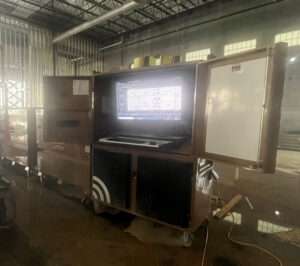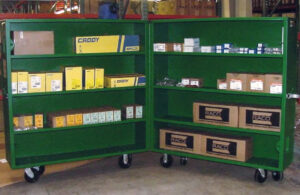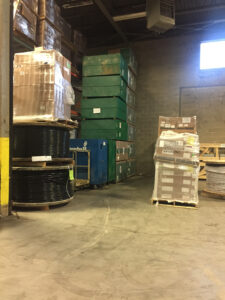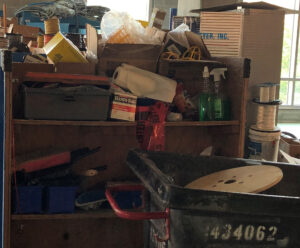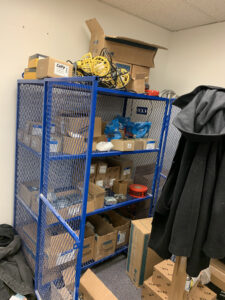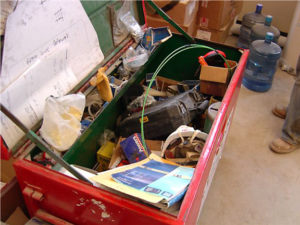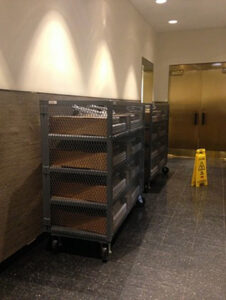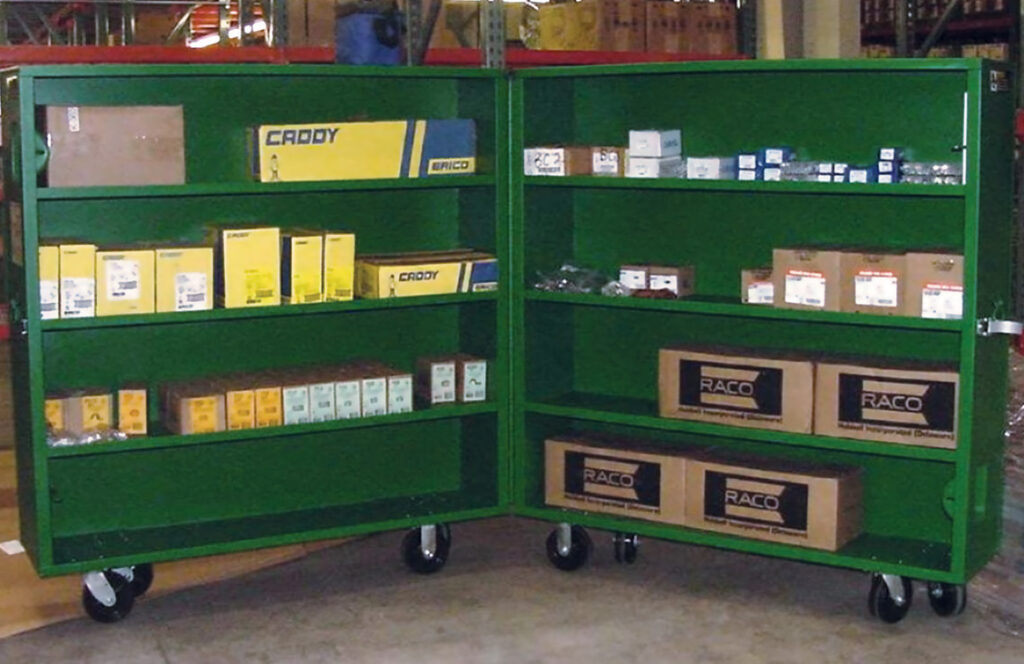By Dr. Heather Moore, with contribution from Deanna O’Dell, MCA, Inc.
Gang boxes have been around as long as construction sites, and their purposes have evolved to store whatever is needed at the site, mostly tools and material. About 10 years ago, we described the concept of a Productivity Integration Center, as a part of the future Industrialization of Construction®, (January, 2017, IEC Insights Magazine -The Winds of Change and the Event Horizon, 2013, IEC Insights Magazine – Industrialization of the Construction Industry, Wikipedia; Industrialization of Construction®, Industrialization of Construction® Series by Dr. Perry Daneshgari and Dr. Heather Moore Book 1: 2016, Competing in the New Construction Environment: A Compilation to Lead the Way. Book 2, 2016: Industrialization of Construction: A Compilation to Lead the Way. Book 3: 2017, Foundation and Future: Dealing with the Challenges of More Work. Book 4: 2017, Efficiency and Continuous Improvement: Survival of the Unfits.) where work will happen less and less at the jobsite itself and the item most valuable to store is information. This concept has started to take off, with several manufacturers offering at least a container for information storage (Figure 1). However, knowing what is needed, where it is needed, and how it is needed at the jobsite still remains a very tacit and analogue process.
Productivity Integration Center, as a part of the future Industrialization of Construction®, (January, 2017, IEC Insights Magazine -The Winds of Change and the Event Horizon, 2013, IEC Insights Magazine – Industrialization of the Construction Industry, Wikipedia; Industrialization of Construction®, Industrialization of Construction® Series by Dr. Perry Daneshgari and Dr. Heather Moore Book 1: 2016, Competing in the New Construction Environment: A Compilation to Lead the Way. Book 2, 2016: Industrialization of Construction: A Compilation to Lead the Way. Book 3: 2017, Foundation and Future: Dealing with the Challenges of More Work. Book 4: 2017, Efficiency and Continuous Improvement: Survival of the Unfits.) where work will happen less and less at the jobsite itself and the item most valuable to store is information. This concept has started to take off, with several manufacturers offering at least a container for information storage (Figure 1). However, knowing what is needed, where it is needed, and how it is needed at the jobsite still remains a very tacit and analogue process.
As researched and validated (July 2015, IEC Insights Magazine, Optimize Jobsite Material to Improve Productivity & Cut Costs) by MCA, Inc., material handling represents about 40% of effort spent by electricians on jobsites. Walk onto many job sites, and it’s not uncommon to see extreme clutter everywhere (Figure 2) —and the same goes for gang boxes, clamshells, etc.
According to in-house research from MCA, up to 5% of an electrical laborer’s time could be spent looking for tools and materials on the job site. Those lost manhours in retrieving, handling, moving, and storing tools/materials can be extremely expensive. Gang box management is nothing more than what material suppliers do in their warehouses yet having an interface to the source of what is needed, where, and when is the missing link.
Many vendors claim to offer “VMI” as a service for their customers (April 2015, IEC Insights Magazine, Vendor Managed Inventory). However, walking jobsites shows evidence of three types of gang boxes currently in existence with minimal attention to inventory management. The concept of a next-generation gang box is also outlined further below. Take this article to your jobsites and see which category you are using or supporting.
- Dust and Trash Collectors. Following a very successful collaboration between a vendor and a committed relationship (that went beyond
price) with one of its customers, what used to be VMI-managed clamshells (Figure 3) became dust collectors (Figure 4), and many gang boxes similarly turn into trash collectors (Figure 5) on the jobsite. Vendors often have material storage and movement solutions that end up in the back of the warehouse because their needs become forgotten.
- Standing By. This is the most commonly observed gang box, which is either a piece of furniture or a stow-away closet at the jobsite. Nobody knows what is in them, where it came from, or where it should go next, and at the end, countless hours are spent to get rid of them. Figures 6 & 7 show examples.
- At Attention. This is the industry’s current leading edge of material storage management, where the project team (Field Lead, Project Manager, Procurement) develop a plan for material handling such that the material is delivered to its final location for install, in the needed quantity, and a few days before it is needed. Figure 8 shows an example of this, with material delivery carts delivered right outside the area of installation, with prefabricated fixtures for exactly what needs to be installed that day.
To avoid going from at attention to dust collector, a visible and repeatable process is needed between contractor and vendor. One proven and easy method is Short Interval Scheduling, SIS® (October 2010, IEC Insights Magazine, How to Increase Your Profits by More Than 30 Percent) to identify material needs ahead of time, from the field perspective. You can also accomplish this by creating a Work Breakdown Structure (October 2014, IEC Insights Magazine, How to Manage Your Job Using Work Breakdown Structure) for each phase of the work (sitework, layout, rough-in, finish, etc.). Next, create a checklist of content for various phases of the job. Identify how many gang boxes for material and tools you would need and determine what time you will need them. Then, develop a plan for how to move gang boxes in and out of specific areas as the different phases of work progress.
- Agile Intelligence™. Looking ahead 10 years (as we did in 2013, introducing the concept of the PIC), job sites themselves will be short-lived and raw materials no longer present. The digital gang boxes that are become more of a norm today (Figure 1) are a good start, but still need to be populated with Agile Intelligence™, such as:
- What material is needed next, and where is it / when will it be here?
- Why is material sitting for more than three days?
- Where is the install location for the material, and what tools are needed to get it done?
- Did the material get installed as planned? If not, why not?
The information to answer these questions currently exists, but in an analog form between:
- Vendor ERP systems
- Manufacturer MRP systems
- Contractor POs
- Electricians’ plans or heads
To build the future intelligence, we recommend MCA, Inc.’s approach to DCI™ (Digitalization, Commonization, Interconnectivity) to capture knowledge and experience and avoid one-off solutions. This approach involves recognizing and mapping the way people do things successfully in the field or the company overall, and developing a common approach and technology to support it which may interconnect with other technologies and tools in the company.
In conclusion, gang boxes haven’t changed in purpose, and very little in shape over the years. They are meant to store stuff, but what that stuff is needs to evolve with the industry’s pace and needs. Vendors have more capabilities than are often used, as experts in material management. However, they need to know the jobsite and project team’s needs and conditions to be effective. Most gang boxes today still end up with clutter of material, tools, and even garbage. If the Agile Intelligence™ is not put in place of the new digital gang box concepts, the same clutter will prevail in computers and data centers, with useless and forgotten information.
